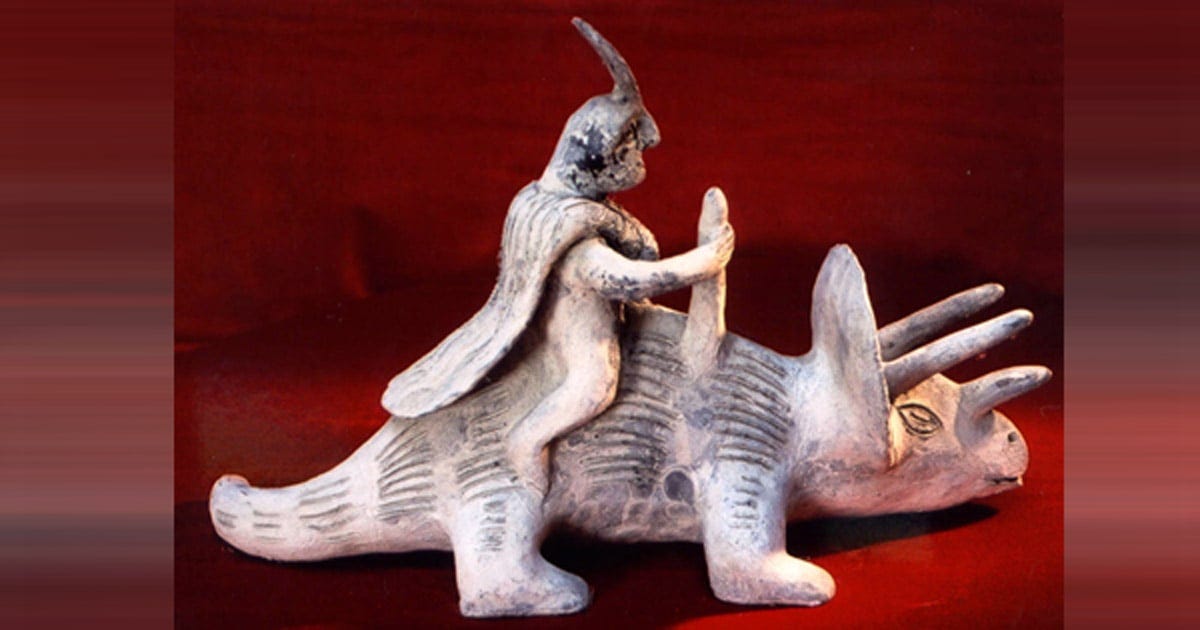Acambaro Figurines: Are They Proof of Human and Dinosaur Interaction?
The general consensus among mainstream paleontologists and geologists places the existence of dinosaurs between 220 million and 65 million years ago, during the Mesozoic Era. In contrast, Homo sapiens, as per historical records, only emerged around 200,000 years ago - during the Middle Pleistocene, Middle Paleolithic (Eurasia), or Middle Stone Age (Africa). Despite this, there are sporadic claims suggesting that dinosaurs and humans might not be so chronologically distant, implying they could have coexisted at some point. The curious Acámbaro figurines serve as a testament to this idea.
Unveiling the Acámbaro Figures
In 1944, a German merchant named Valdemar Julsrud alleged to have accidentally discovered peculiar figurines while riding a horse near Acámbaro, in Guanajuato, Mexico. He found over 30,000 such artifacts with the assistance of a local farmer. The unique aspect of these figurines is their depiction of dinosaurs and humans living together. Moreover, a few other odd figurines closely resemble flying saucers and possibly, extraterrestrials.

The majority of archaeologists have dismissed these figurines as fraudulent since thermoluminescence studies and the surface analysis of these artifacts suggest a very recent origin. However, these studies haven't discouraged those who don't conform to mainstream archaeological beliefs and hold alternative theories about the figurines' beginnings.
Did Humans Walk the Earth with Dinosaurs? Triceratops Horn Dated to 33,500 Years
17 Out-of-Place Artifacts Said to Suggest High-Tech Prehistoric Civilizations Existed
First-Ever Fossilized Dinosaur Brain Tissue Discovered in Sussex, England
Those who argue the authenticity of the artifacts can be grouped into three categories: cryptozoologists who insist the figurines serve as proof of a residual dinosaur population that interacted with humans, advocates who suggest the figurines were remnants from interdimensional aliens who could time travel and share knowledge about dinosaurs with Central American communities, and young earth creationists who believe the coexistence of humans and dinosaurs aligns with their interpretation of Genesis chapters 1-11 in the Bible. The first viewpoint aligns most closely with the mainstream perspective. However, these interpretations don't hold much weight unless the authenticity of the collection is first scrutinized.

Scrutinizing Their Authenticity
At first glance, a significant issue with the legitimacy of the Acámbaro figurines is the scarcity, or complete absence, of nearby dinosaur fossils. Additionally, there are no written records or oral traditions suggesting the existence of dinosaur-like creatures in the region. If such creatures were frequent enough for thousands of figures to be made in their likeness, they should have also appeared more frequently in local folklore, much like jaguars and butterflies do. A website advocating their authenticity states that the area lacks a recent local pottery tradition. However, if this assertion is accurate, it also implies that the figurines might not have been created in the region, even if they are merely an elaborate deception.

In 1952, Charles Di Peso, an American archaeologist, examined the artifacts and concluded that their surfaces lacked weathering or dirt accumulation in the crevices, which would have indicated a significant age. Based on these observations, he deemed the figurines to be recent creations. He also claimed that the family that originally provided the figurines to Julsrud had produced them for a single peso each. Further, the figurines bore resemblance to creatures and characters that the family could have seen in films at a local cinema in Acámbaro or comic books accessible in a nearby city's museum. These findings question the veracity of the artifacts.

From 1969 to 1972, thermoluminescence dating was applied to a selection of the figurines. The analysis resulted in a date approximately 4500 years before present, thus placing the figurines' age around 2500 BC. Supporters of the artifacts' authenticity saw this as proof of their genuineness. However, subsequent studies in 1976 and 1978 indicated that the initial date was incorrect and that the figurines failed to meet the temperature conditions necessary for reliable thermoluminescence dating. The dates that could be obtained suggested that the figurines originated in the late 1930s or early 1940s - right before their supposed "discovery."
Do the Ica Stones prove that mankind coexisted with dinosaurs and had advanced technology?
Studies Begin on a Crater That May Explain the Dinosaur Extinction 65 Million Years Ago

Are the Figures Really Dinosaurs?
These discoveries all cast a shadow over the authenticity of the figurines. Even if the figurines are legitimate, it's unclear whether they actually represent dinosaurs. For instance, many figurines, supposedly representing dinosaurs, feature only two legs – contrasting with the four legs usually associated with certain dinosaur species. Some archaeologists have proposed that, if real, they might instead portray stylized non-dinosaur animals or mythical beasts.

While it's possible that humans and dinosaurs coexisted, this discovery doesn't seem to substantiate that claim. Even the prominent young earth creationist group, Answers in Genesis, which would be keen on any evidence supporting the coexistence of dinosaurs and humans, has expressed that this is likely a hoax.
The outcomes of various studies imply that the Acámbaro figures don't provide evidence of dinosaurs living alongside humans - thereby posing no challenges to the prevailing assertions of paleontologists and geologists that dinosaurs became extinct 65 million years ago, at the conclusion of the Cretaceous period.

Top Image: A famous Acámbaro figurine depicting a human apparently riding a dinosaur. Source: Creative Commons
By Caleb Strom
References
Abrahams, I. (2011) Kachina Bridge Dinosaur Petroglyph: Still Good Evidence. Available at: https://answersingenesis.org/dinosaurs/humans/kachina-bridge-dinosaur-petroglyph/
Di Peso, C. C. (1952) The Clay Figures of Acambaro, Guanajuato, Mexico. Available at: http://www.michaelsheiser.com/PaleoBabble/The%20Clay%20Figurines%20of%20Acambaro.pdf
Fitzpatrick-Matthews, K. (2007) The Acámbaro figurines. Available at: http://www.badarchaeology.com/out-of-place-artefacts/mysterious-objects/the-acambaro-figurines/
Pezzati, A. (n.d.) Mystery at Acámbaro, Mexico: Did Dinosaurs Co-Exist with Humans? Available at: http://www.michaelsheiser.com/PaleoBabble/Pezzati%20PENN%20Expedition%20Acambaro%20figures.pdf
The Greater Picture. (n.d.) The Waldemar Julsrud Collection. Available at: http://thegreaterpicture.com/Waldemar_Julsrud.html

